She wants to broaden the view of sustainability

Tove Malmqvist's teaching focuses on the climate issue. How can we build a society without unnecessary strain on the environment?
“There is great potential for reducing emissions and we need a lot of educated people out there who understand how we can achieve this," she says.
Ever since she came to KTH as a PhD student, sustainable construction has been at the centre of Tove Malmqvist's work, both as a teacher and researcher. In the master's course The environmental impact of buildings, which she has designed and run for over a decade, she wants to convey a holistic perspective.
“What is the right environmental approach in one construction project may be wrong in another. It all depends on the context. Whether it's a renovation or a new building, for example, and depending on where we are in the world,” she says.
She replies with confidence, yet chooses her words carefully during the interview. "Good question," she says several times before sharing her thoughts on her role as an educator. In teaching, she uses several types of learning and activities: teacher lectures, invited industry representatives, computer labs, seminars and workshops.
“Everyone receives knowledge in different ways. Some students enjoy doing maths in computer labs, others are inspired by group discussions or reading and reflecting before a seminar”, she says.
Mix students
To mimic working life in the study situation, her students work in project groups. Many have different backgrounds and levels of prior knowledge, with different specialisations in their undergraduate education - engineering or social sciences - and some with an international background.
“We mix students with different competences so that they can learn from each other. In professional life, many will work in projects with many different aspects to be managed and evaluated, so it can be good to have practised this”, she says.
Common professional roles after graduation are urban planners and expert roles regarding the environmental impact of buildings, often with titles such as environmental strategist and climate expert in the construction and property sector.
Critical thinking
She sees encouraging critical thinking as one of her most important tasks:
“We constantly encounter messages that things are sustainable and positive for the climate. But what does it really mean and what should it mean? It's about getting the tools from the programme in order to be able to scrutinise such statements.
Do you have any special tricks if teaching is slow?
“I try to be as present as possible and follow up with the students so that everyone can keep up. Sometimes I use oral examinations to be able to sit down and discuss and clarify certain concepts. Then the penny can drop and it also gives me, as a teacher, insight into what can be difficult to understand.”
As a researcher, her focus has since her PhD been to develop methods that can assess the environmental impact of buildings. That the methods should make sense of the environmental impact and guide the industry. Sometimes she hires students to do thesis work for research projects.
Large climate impact
Most recently, she asked students to sort and categorise large amounts of data on how different materials, such as windows, roofs and bathroom interiors used in renovations, affect climate emissions. It all came down to the potential for climate savings.
“Students tested climate calculations and developed their understanding of life cycle assessment.”
The construction industry is one of the sectors with a relatively large climate impact, mainly through the use of energy and materials. About 20 per cent of society's climate impacting emissions can be linked to the building sector, according to Malmqvist.
“Thinking on a system level is crucial to moving forward. An overview makes it clear that you may need to take into account that several environmental goals are to be achieved,” she says.
Text: Christer Gummeson ( gummeson@kth.se )

